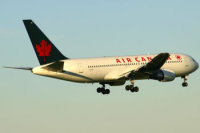The Gimli Glider
- Metric Tags:
- metric,
- metrication,
- fun,
- Gimli,
- Glider
That’s exactly what happened on July 23, 1984. Captain Bob Pearson and First Officer Maurice Quintal were flying the aircraft, but due to mechanical difficulties the fuel gauges weren’t working. This was realized during a stopover in Montreal and the plane was still allowed to fly, but the amount of fuel had to be calculated manually. Mechanics knew that the plane would need 22,300 kilograms of fuel to fly from Montreal to its destination in Edmonton, and they were also able to determine that there were 7,682 liters of fuel in the tank at that time.
The flight crew then [incorrectly] calculated that they needed to add 4,916 liters from the fuel truck. How did they do this? They multiplied the total of 12,598 liters by the conversion factor 1.77, which gave 22,298. The problem is that 1.77 is the number of pounds per liter, not the number of kilograms per liter: the Boeing 767 was the first Air Canada airplane to use all-metric units, so the standard conversion factor of 1.77 didn’t apply.
This incorrect conversion meant that they actually had about 22,300 pounds of fuel on the plane, which is only 10,115 kilograms of fuel. Because the fuel gauges weren’t working, they didn’t discover their error until they got a low-fuel light mid-flight. The plane was near Winnipeg, but not close enough to land; instead they diverted to the small town of Gimli, which had a decommissioned Royal Canadian Air Force Base. In a stroke of good luck, Quintal had been stationed there when he served in the airforce, so he was familiar with the runways. In a stroke of bad luck, the runways were currently being used as a dragstrip, and that very day was “Family Day” for the Winnipeg Sports Car Club.
In a stroke of amazing luck, Pearson did some excellent maneuvering and safely landed the plane amid all the people. No one on the ground was hurt, and the only injuries (none life-threatening) occurred when people tried to exit the plane. There was one additional delay, though: the mechanics who came from Winnipeg to Gimli to repair the aircraft got stuck in the back woods because they ran out of fuel. The Gimli Glider was repaired and flew for another twenty years.
Its final flight was on January 24, 2008; Pearson and Quintal (and apparently the rest of the July 23 flight crew) were on that flight. Most of the information here comes from “The 156-tonne Gimli Glider” by Merran Williams, Flight Safety Australia (July-August 2003), pp. 22-27 and “The Gimli Glider” by Wade H. Nelson. Both articles have a great (copyrighted) picture of what the plane looked like after it landed; Nelson also offers to send teachers Math Lessons using the Gimli Glider. The update comes from “Famous Gimli Glider retired from Air Canada service” in the Vancouver Sun and from Wikipedia. source:
http: //threesixty360.wordpress.com/
